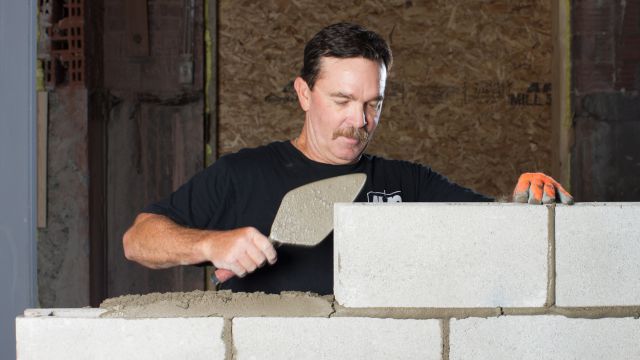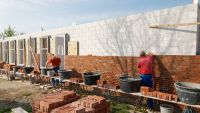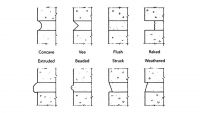Navigating LEED v4 for Concrete Masonry
Concrete masonry can be conceptualized as a green building material
By Jennifer Wagner, Christie Gamble
Phil Bonnell has reason to be proud of the sustainability profile of his company. As VP and general manager of Basalite Concrete Products Northwest Region, Bonnell always has felt proud to provide an inherently sustainable product to a customer base that places high value on everything green.
During the last year however, Bonnell has been exceptionally pleased with the joint efforts that he and his local competitor, Mutual Materials, under the leadership of Kendall Anderegg, have made to improve the sustainable attributes of the concrete masonry industry in the Pacific Northwest.
For many reasons, concrete masonry can be conceptualized as an inherently green building material. Concrete masonry is resilient as it is largely protected against rotting, mold, fungus and termites, which can negatively affect other building materials.
Masonry’s strength and ability to withstand high winds, rain and fire make it highly desirable in a climate that has become increasingly susceptible to severe weather. Finally, masonry’s thermal mass benefits can reduce energy bills and improve thermal comfort in buildings.
However, one issue that has hampered the concrete masonry industry’s ability to appeal to the green design community is the carbon footprint associated with concrete. Cement production accounts for about 5 percent of the world’s carbon dioxide (CO2) emissions. This has some environmentally conscience designers weary of specifying the material. Now, thanks to Basalite and Mutual Materials, designers in the Pacific Northwest have an option to specify concrete masonry with a reduced carbon footprint.
Basalite and Mutual Materials understand the value in promoting masonry’s sustainable attributes to designers and are jointly promoting the use of CarbonCure’s innovative CO2 recycling technology. Both companies are now manufacturing concrete masonry products with CarbonCure’s technology, which recycles carbon dioxide from the smokestacks of industrial emitters into concrete.
The CO2 is injected into the concrete during mixing, where it becomes chemically converted into solid calcium carbonate. This means that the CO2 gas will never be released into the atmosphere as it no longer exists. The resulting masonry products are greener and are being specified by leading designers in the Pacific Northwest.
In honor of the sustainability efforts put forward by its partners, Basalite and Mutual Materials, the sustainability team at CarbonCure Technologies has prepared a brief description of how concrete masonry can contribute to points in LEED v4 (Leadership in Energy & Environmental Design), the most common green building certification program used in North America.
Contributing to points in the new version of LEED
LEED has always made it a priority to challenge the notion of what makes a material sustainable for manufacturers, designers and building owners. The definition of what makes a building material green has evolved in the latest version of LEED, which is known as LEED version 4 (or LEED v4). In LEED v4, the ability to classify a building material as green takes into account a broad range of considerations, including regional sourcing, recycled content and environmental impact over a product’s life cycle. The LEED system is currently in transition, and new building projects may apply for credits under LEED version 3 (commonly known as LEED 2009) or LEED v4. After Oct. 31, 2016, all new building projects will need to be submitted under LEED v4.Compared to previous versions of LEED, LEED v4 takes a more holistic approach to defining a green building material with a particular focus on life cycle impacts and supply chain management. Architects are now asking manufacturers to collect information from outside of the localized manufacturing processes. In the past, self-declared recycled content and bare bones regional declarations were enough to meet LEED requirements, but under LEED v4, this is no longer the case.
With significant changes to the Materials & Resources section of LEED, less emphasis is being placed on a product’s individual attributes. For example the recycled content credit that used to favor concrete products no longer exists. Under LEED v4, regional materials is not a separate credit, but rather is introduced as a value multiplier that applies to multiple credits for products sourced within 100 miles (changed from 500 miles under LEED 2009).
There are now three new credits that acknowledge a designer’s use of sustainable products, and each is worth two points:
- Environmental product declarations
- Sourcing of raw materials
- Material ingredients
Building Product Disclosure and Optimization – EPDs
The intention of this credit is to encourage manufacturers to report and verify a product’s life-cycle impacts. The best tool for the job is the Environmental Product Declaration (EPD). EPDs are similar to nutrition labels on food products, except they disclose environmental impacts over the lifecycle of a building material.In order to achieve the credit, project teams have several options. One option is for project teams to use a minimum of 20 different permanently installed products from at least five manufacturers that have issued public EPDs. The most common method to comply with this credit is for manufacturers to issue product-specific, ISO-compliant EPDs for full-credit value, or to use generic industry EPDs for half-credit value.
The second option of this credit involves “multi-attribute optimization.” This credit requires that project teams comply with one from a list of criteria for 50 percent of the permanently installed products on the project, by cost. One option is to demonstrate that products have environmental impacts lower than industry averages in at least three environmental categories, including global warming potential (measured by CO2 emissions associated with the product).
Building Product Disclosure and Optimization – Sourcing of Raw Materials
The second Materials & Resources credit, “Building Product Disclosure and Optimization – Sourcing of Raw Materials,” has two options available. The first option is to publish a raw material source and extraction report, which outlines a supplier’s commitments to:- Long-term ecologically responsible land use
- Reducing environmental harms from extraction and/or manufacturing processes
- Meeting applicable standards or programs voluntarily that address responsible sourcing criteria.
Building Product Disclosure and Optimization – Material Ingredients
Three options are available to achieve the “Building Product Disclosure and Optimization – Material Ingredients” credit. However, only the first two options are viable today. The first option is around material ingredient reporting. Projects must use at least 20 different permanently installed products from at least five different manufacturers that use one of the approved programs to demonstrate the chemical inventory of the products.Acceptable approaches include products that have published Health Product Declarations (HPDs), or have been certified by Cradle to Cradle. HPDs are transparency documents similar to EPDs, but they disclose materials that may pose a health risk for either an end-user or a person involved in the manufacturing of that product.
A second option takes it to the next level of optimization, whereby one point is awarded when products are used that document material ingredient optimization using various approved tools. Options of compliance include products that are certified to certain levels under Cradle to Cradle and GreenScreen.
What’s in store for the future?
Basalite and Mutual Materials have the capabilities of contributing to many of the credits under LEED v4. Like many concrete masonry manufacturers, these companies have been providing products with recycled content for many years. Now, with the additional emphasis on sustainability, both manufacturers are capable of providing EPDs and HPDs for products made with the CarbonCure Technology. Additionally, thanks to the reduction of the carbon footprint associated with the use of CarbonCure’s CO2 recycling technology, Basalite and Mutual Materials products are eligible to contribute toward the CO2 emission reduction criteria.As local industry leaders such as Phil Bonnell and Kendall Anderegg continue to promote sustainable masonry practices in the Pacific Northwest, they will continue to seek out new opportunities to reduce the environmental impact of the products they manufacture. Both individuals recognize that implementing CarbonCure’s CO2 recycling technology is just the first step in leading the concrete masonry toward a more sustainable future. But it’s a first step that truly gives Bonnell and Anderegg good reason to be proud.
Originally published in Masonry magazine.
About the Authors
Jennifer Wagner is the Vice President of Marketing at CarbonCure Technologies Inc.
Christie Gamble, LEED Green Associate, is sustainability director at CarbonCure Technologies. Her mission is to educate and engage the design and development community around CarbonCure's efforts to improve sustainability in the concrete industry. Gamble promotes transparency through the creation of Environmental Product Declarations (EPD) and the HPD for CarbonCure's manufacturing partners. She is a LEED Green Associate and an active member of the HPD Manufacturers Advisory Panel developing HPD version 2.0. She earned a Bachelor of Arts from McGill University and MBA from Dalhousie University. Christie can be reached at 902-442-4020 or or by email at cgamble@carboncure.com.



















